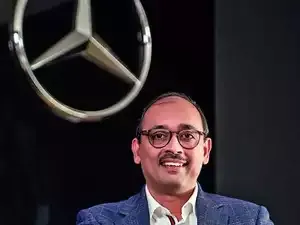India is discussed more often these days at our headquarters and in board meetings, more than ever in the last 10-15 years. Is this because of 'India Ascends', which is increasingly becoming one of the brighter spots in the global economy? The answer is absolutely affirmative. This enthusiasm about India is buoyed by confidence, trust and resilience that the Indian market has displayed, especially after the black swan of the pandemic. Backed by supportive government policies, a long-term vision and a favourable business environment, the Indian manufacturing in general and automotive manufacturing ecosystem in specific is well-poised, presenting unlimited potential. This potential is underscored by strong domestic consumption and growing international demand for our products and services.
It is initiatives like 'Make in India' that have played a pivotal role in boosting the automotive manufacturing prowess, building confidence in local competencies, in local talent pool having global capabilities, positioning India as a potential 'global manufacturing hub'. For instance, we now produce two world-class electric vehicles (EVs) in Pune, the first market outside Germany and the US to accomplish this feat.
The country's manufacturing sector, contributing about 17% of India's GDP and employing over 27 million, remains the backbone of economic transformation that will eventually catapult it to the 'developed economy' badge. 'Viksit Bharat' is a transformation that can push ahead with the realisation of India becoming the third largest economy by 2030, and manufacturing and automotive segments are bound to play a pivotal role.
From a luxury original equipment manufacturer (OEM) perspective, we view automotive manufacturing growth passively related to the Indian market's high growth potential. Today's upwardly mobile youth is driven by a desire for a better lifestyle, wants higher disposable income, has aspirations. This presents an unprecedented potential for the domestic consumption as a key indicator for the manufacturing sector, to leap ahead and support this substantial demand. We call this the 'Luxury Index' internally, which indicates the 'desire quotient' of our young, successful and aspirational customers. A high 'Luxury Index' will signify positive sentiment and rise in consumption of luxury goods. It will be our endeavour that this index is always high, and keep driving India's economy and contribute to the GDP.
Scripting India's manufacturing revival must be a well-thought strategical endeavour. While substantial headwinds exist in form of regulatory complexities, skill gaps in workforce, need for rapid infrastructure and technology adoption, or even the need for rationalisation of duties, long-run growth opportunities will ultimately outpace the challenges, making the manufacturing sector 'aerodynamic champion', simply meaning highly efficient.
The brightest enabler of all opportunities is the youth and focus must be on leveraging this talent pool with upskilling to leverage the immense potential that digital revolution in manufacturing can introduce. Here, inclusion of women should be of utmost relevance. In India, if we can cleverly network talent pool with machines and emerging industrial processes, we can achieve highly qualitative industrial output and make manufacturing cost efficient and globally competitive.
Digitisation of the value chain will play a crucial role in revitalising manufacturing, opening new opportunities by leveraging technology and innovation. With Industrial 4.0, globally, the entire value chain is getting digitised with robotics and AI transforming industrial production processes. Applications like Open Universal Scene Description are developing industrial digitisation like 'Digital Twins'. With this, assembly lines can be planned, retooled and virtually inspected. OEMs can directly interact with suppliers, halve coordination processes, while improving cost efficiencies. We need to adapt 'Digital First' approach in the Indian manufacturing ecosystem to make it highly cost-effective, agile, resilient and future ready.
Much has been achieved, but much more needs to be done in context of manufacturing sector that also includes automobiles, but I am a firm believer in complete implementation of plans that matter the most to end-customers and the people at large. To script not just a 'revival', but continued success of India's manufacturing prowess, pushing it into 'mahamarg of growth', we need earnest cooperation of policy makers, continued collaboration with industry, regular outcome-oriented and meaningful dialogues with academia, civil society and corporates, who are all equal stakeholders in the transition to 'Viksit Bharat'.
The writer is MD & CEO, Mercedes-Benz India
US Election 2024
US Election Result Live Updates
Swing state results deciding who'll be new POTUS
Trump vs Harris: Who’s winning which state? Full list
The country's manufacturing sector, contributing about 17% of India's GDP and employing over 27 million, remains the backbone of economic transformation that will eventually catapult it to the 'developed economy' badge. 'Viksit Bharat' is a transformation that can push ahead with the realisation of India becoming the third largest economy by 2030, and manufacturing and automotive segments are bound to play a pivotal role.
From a luxury original equipment manufacturer (OEM) perspective, we view automotive manufacturing growth passively related to the Indian market's high growth potential. Today's upwardly mobile youth is driven by a desire for a better lifestyle, wants higher disposable income, has aspirations. This presents an unprecedented potential for the domestic consumption as a key indicator for the manufacturing sector, to leap ahead and support this substantial demand. We call this the 'Luxury Index' internally, which indicates the 'desire quotient' of our young, successful and aspirational customers. A high 'Luxury Index' will signify positive sentiment and rise in consumption of luxury goods. It will be our endeavour that this index is always high, and keep driving India's economy and contribute to the GDP.
Scripting India's manufacturing revival must be a well-thought strategical endeavour. While substantial headwinds exist in form of regulatory complexities, skill gaps in workforce, need for rapid infrastructure and technology adoption, or even the need for rationalisation of duties, long-run growth opportunities will ultimately outpace the challenges, making the manufacturing sector 'aerodynamic champion', simply meaning highly efficient.
The brightest enabler of all opportunities is the youth and focus must be on leveraging this talent pool with upskilling to leverage the immense potential that digital revolution in manufacturing can introduce. Here, inclusion of women should be of utmost relevance. In India, if we can cleverly network talent pool with machines and emerging industrial processes, we can achieve highly qualitative industrial output and make manufacturing cost efficient and globally competitive.
Digitisation of the value chain will play a crucial role in revitalising manufacturing, opening new opportunities by leveraging technology and innovation. With Industrial 4.0, globally, the entire value chain is getting digitised with robotics and AI transforming industrial production processes. Applications like Open Universal Scene Description are developing industrial digitisation like 'Digital Twins'. With this, assembly lines can be planned, retooled and virtually inspected. OEMs can directly interact with suppliers, halve coordination processes, while improving cost efficiencies. We need to adapt 'Digital First' approach in the Indian manufacturing ecosystem to make it highly cost-effective, agile, resilient and future ready.
Much has been achieved, but much more needs to be done in context of manufacturing sector that also includes automobiles, but I am a firm believer in complete implementation of plans that matter the most to end-customers and the people at large. To script not just a 'revival', but continued success of India's manufacturing prowess, pushing it into 'mahamarg of growth', we need earnest cooperation of policy makers, continued collaboration with industry, regular outcome-oriented and meaningful dialogues with academia, civil society and corporates, who are all equal stakeholders in the transition to 'Viksit Bharat'.
The writer is MD & CEO, Mercedes-Benz India
(Disclaimer: The opinions expressed in this column are that of the writer. The facts and opinions expressed here do not reflect the views of www.economictimes.com.)








